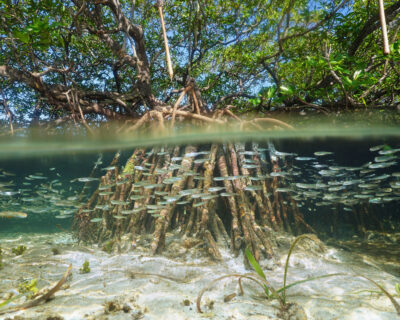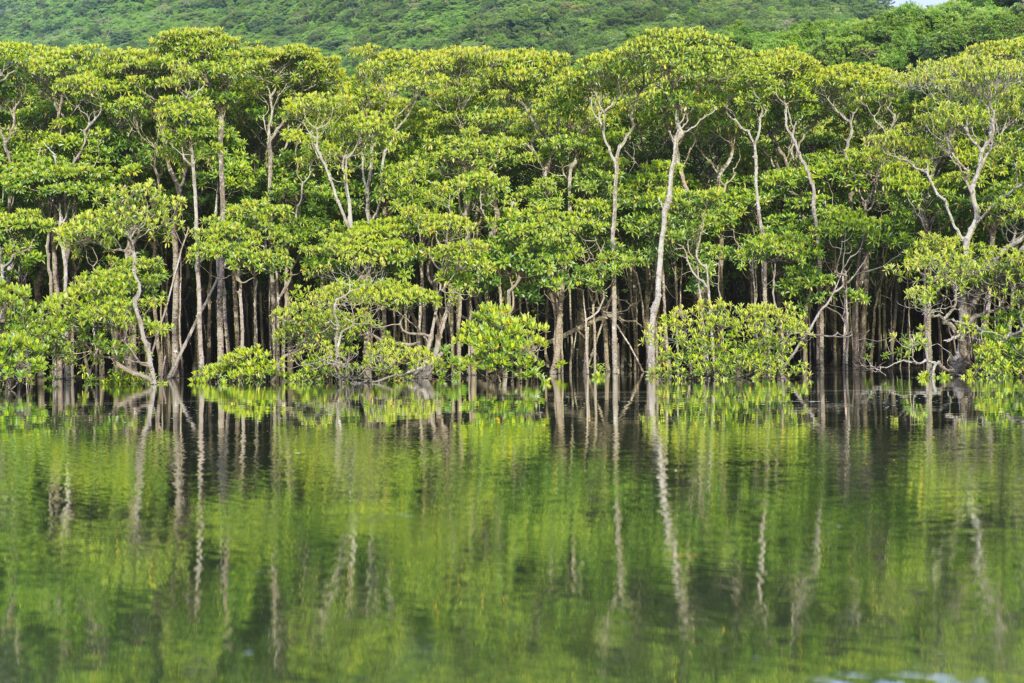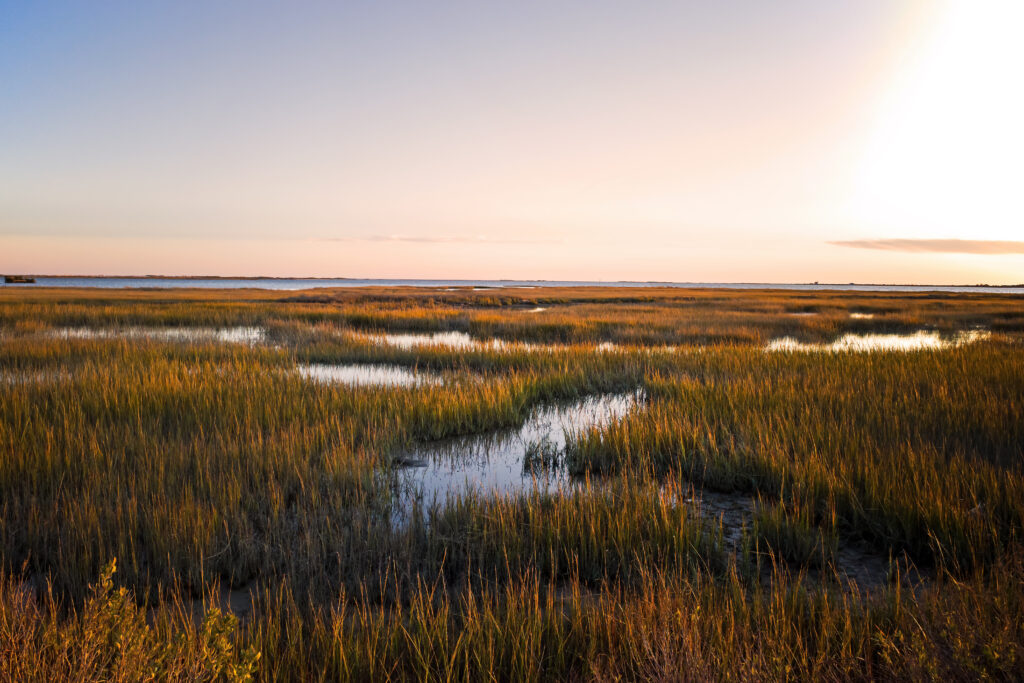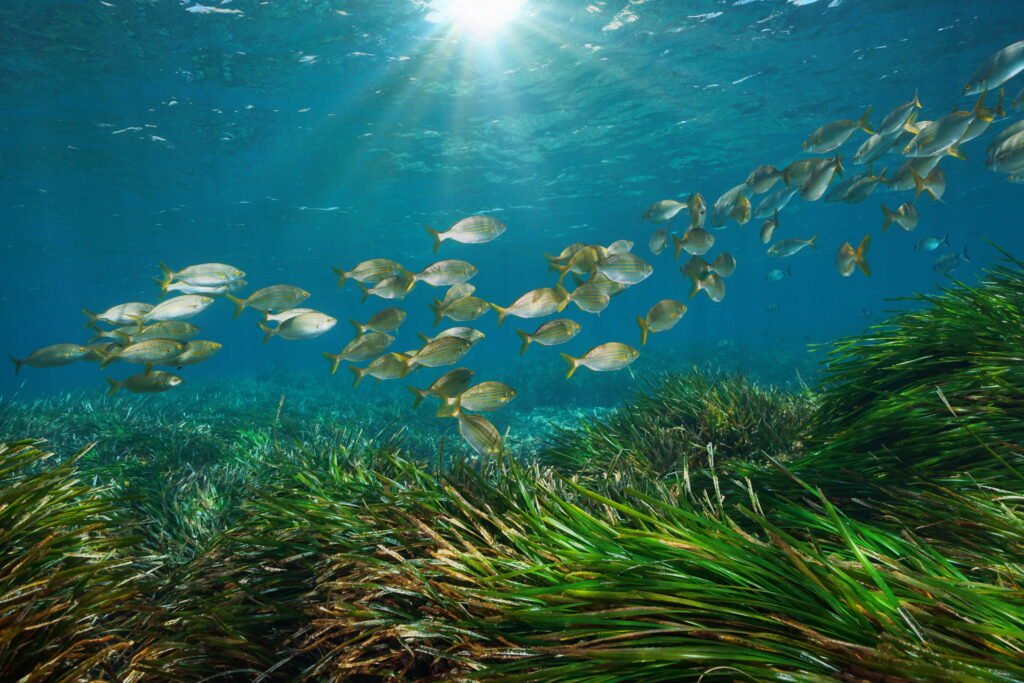
Healthy blue carbon ecosystems are a victory for animals, people, and the planet.
Carbon is everything. And it’s everywhere.
All living things contain carbon; we’re all part of the carbon cycle. Animals breathe in oxygen and breathe out carbon dioxide (CO2). Plants take in that CO2 and release more oxygen. It’s a delicate balance that makes life on Earth possible.
But that balance extends beyond just flora and fauna. The right amount of CO2 is needed to maintain the protective blanket of Earth’s atmosphere. Too little CO2, and we’d all freeze. Too much and, well, welcome to today’s climate crisis, where an exorbitant amount of CO2, produced chiefly by human activities, is causing catastrophic global warming.
Historically, nature keeps this balance in check in the form of carbon sequestration. Forests, soil, grasslands, and even certain rocks capture carbon dioxide before it can be trapped in the atmosphere and contribute to global warming.
But there’s another form of carbon sequestration just under the water’s surface that is imperative to combat climate change: blue carbon.
What is blue carbon?
Blue carbon is the term used to describe carbon sequestered, or captured, by ocean and coastal ecosystems. Research shows that blue carbon ecosystems sequester up to four times more carbon per hectare than land-based forests. Blue carbon This occurs via carbon sinks, components of coastal habitats that “extract carbon dioxide from the atmosphere and absorb more carbon than they release,” according to Earth.org. Interestingly, most of what’s sequestered through blue carbon is stored in sediments beneath the surface of the water. In many cases, carbon trapped in the soil of coastal habitats has been there for thousands of years.


Types of blue carbon ecosystems
There are three main types of blue carbon ecosystems, each with unique characteristics: mangroves, salt marshes, and seagrasses.
Scientists estimate that mangroves cover nearly 60,000 square miles of the Earth’s surface across more than 50 species and 16 families. These trees and shrubs, typically found along tropical and subtropical coastlines, feature sprawling and snarled roots that rise above the water’s surface.
Although they make up less than 2% of all marine environments, the world’s mighty mangrove forests account for between 10 and 15% of carbon burial. To put that into context, one acre of mangrove forest can potentially store the same amount of carbon as a car would emit if driven across the country—and back.
Located between land and open salt- or brackish water, salt marshes are coastal wetlands that serve a number of different purposes. Salt marshes provide shelter to small fish, crabs, and shrimp. And like fellow blue carbon ecosystems—mangroves and seagrasses—salt marshes also act as a buffer for inland communities against the threat of erosion, flooding, typhoons, cyclones, and hurricanes. Astonishingly, a salt marsh can take in up to 1.5 million gallons of floodwater. They also sequester nearly 2,000 pounds of carbon per acre per year. Although half of the country’s salt marshes are found along the Gulf Coast, salt marshes exist on every coast in the U.S. and throughout the world.
The last of the big three blue carbon ecosystems, seagrasses, is as misunderstood as it is valuable. Commonly confused for the similarly sounding seaweed, an alga with no vascular tissue, seagrasses are vascular plants with roots, stems, and leaves. Some 72 different seagrass species exist in shallow, salty, and brackish waters worldwide. Like mangroves, seagrasses provide a tremendous benefit, despite occupying a shockingly small footprint. Only about 0.1% of the ocean floor includes seagrasses—but they are still responsible for 11% of the ocean’s buried organic carbon. That equates to up to 83 million metric tons of carbon collected annually, or about the same as the amount of emissions produced each year in states like Minnesota, Colorado, or Arizona.
How carbon in the atmosphere impacts the environment
While both blue carbon and terrestrial ecosystems can capture millions of tons of carbon dioxide each year, the reality is that more carbon is released into the atmosphere than natural methods can remove. Analysis from the National Oceanic and Atmospheric Administration (NOAA) uncovered that the global average atmospheric carbon dioxide was 414.72 parts per million in 2021, a new record high. Even more alarming, the year-over-year increase from 2020 of 2.58 parts per million represented the fifth-largest single-year jump in NOAA’s 63 years of monitoring.
As mentioned earlier, a moderate amount of carbon dioxide and its ability to absorb and radiate heat is a good thing. Without it, the average global surface temperature would struggle to reach above freezing. The problem is when excessive amounts of carbon dioxide—like we’ve experienced since the mid-20th century as fossil fuel emissions began to skyrocket—are released into the atmosphere, global warming occurs at a hazardous rate. As a result, the Earth will continue to encounter disastrous conditions, including sea ice loss, sea level rise, intense heat waves, the shifting of plant and animal geographic ranges, ocean acidification, and more.


The importance of coastal conservation
Blue carbon can help mitigate those risks, but unfortunately, threats to blue carbon ecosystems are abundant. Shrimp farming, coastal development, unsustainable resource use, and pollution are a few top reasons why carbon sinks like mangroves are at serious risk. As these limited resources are removed, there becomes even less available for sequestration. A damaged carbon sink will release any stored carbon back into the atmosphere, with The Pew Charitable Trusts reporting that about 450 million metric tons of CO2 is emitted each year solely due to the destruction of coastal wetlands.
To help combat these effects, a concerted effort is underway to conserve our coasts through initiatives that establish protections and sustainable management for these vulnerable ecosystems. Coastal networks of marine protected areas are one tool that can help prevent loss and degradation of these habitats, and their associated blue carbon reserves. They may also enable new carbon sequestration through the restoration of degraded marine habitats or carbon storage within sediments.
Healthy blue carbon ecosystems are a victory for animals, people, and the planet. When these environments flourish, carbon is collected, fish stocks and food security levels are high, water is properly flowing into oceans and reef systems, and coastlines help protect inland communities. Local livelihoods depend on these coastal ecosystems, which is another reason why conservation initiatives are so vital.


Protecting coastal habitats
Establishing stronger protections, improving management, and strengthening monitoring and enforcement are critical to safeguarding coastal ecosystems.
For two decades, WildAid’s marine team has focused on marine enforcement that strengthens monitoring and surveillance of detrimental marine activity. Through this work, we have improved protections for more than 8,500 marine species—and we’re not done yet. Over the next five years, our goal is to enroll 250 marine areas in our BLUEPRINT for Marine Protection™, which will provide a significant benefit for marine life, big and small, and the coastal communities who depend on them.
Learn more about how WildAid’s marine program is making the promise of marine protection real.
Stay in touch and get the latest WildAid updates.
SIGN UP